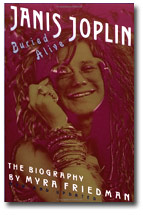Books |
Buried Alive: The Biography of Janis Joplin
Myra Friedman
By
Published: Jan 01, 2006
Category:
Biography
Everybody knows about Janis Joplin. She had that raspy Texas voice and those hippie clothes and she drank and swore like a guy. She was famous for being wild, famous for giving everything she had every time she sang. And then, just two weeks after Jimi Hendrix died, she overdosed on heroin in a Los Angeles motel room. RIP the ’60s.
Myra Friedman was Janis Joplin’s best friend at the time. She was also her publicist, which is to suggest how hard up for friends Janis was. Happily for us, Myra Friedman is an extremely decent person who has a great memory, a large commitment to the truth and a unique vantage point to tell the story of a slow-motion suicide.
Joplin’s family didn’t like this book when it first appeared in 1973. Neither, if you read the comments on Amazon.com, do her fans. "Buried Alive" is a harsh, relentless read that is neither a tell-all or a hype job. It’s just a story of one step up, two steps back. Here’s Joplin being voted "ugliest man on campus" at the University of Texas. Here she is sleeping with anyone who would sleep with her. Here she is, unable to be alone. Unable to live without liquor or drugs. Unable to live, period, and so, holding nothing back, coming (ironically) to be cast as a woman who lived full-tilt. "Man, I’d rather have ten years of superhypermost than live to be 70 sitting in some goddamn chair watching TV," she said. And everyone thought that was righteous. And she died at 27.
Of the many strengths of this book — which is among the best biographies on my music shelf — is the reporting that Friedman has done on Joplin’s childhood. She did not, as you might think, come from the wrong side of the tracks and suffer a hardscrabble childhood. Her father, an engineer for Texaco, read Robert Graves; her mother was attentive and loving. But Janis was unattractive and needy — hers is a sad story we have all witnessed, the story of the ugly girl.
Her weight went up, and up again. Her skin was so bad her face had to be sanded. And, by 14, she had opinions that might have been tolerated if she had been a pretty Southern deb-in-training, but were death to a fatty. She became, says Friedman, "as hated as an epidemic of horse fever." What is such a girl to do? Again, the story is cliche: hang out with "bad" kids, drink and drug, have sex with anyone who will have you. Joplin broke through in one way: She could sing. And, through her singing, she could convert her pain into audience pleasure and approval. Goodbye, Texas. Hello, San Francisco.
In l965, there were a handful of bands in San Francisco: The Grateful Dead, Jefferson Airplane, Country Joe and the Fish, Quicksilver Messenger Service. Janis arrived just in time to power Big Brother and the Holding Company. A year later, with 1,500 bands in San Francisco, she was a queen. [To buy the paperback from Amazon, click here.]
Albert Grossman was the next step. He managed Dylan and The Band. He was both silent and witty. He inhaled power. He exhaled contempt. Big Brother signed with him. The band said, "We must make $75,000 a year." Grossman shrugged. "Say $100,000," he said, and he put that figure in the contract.
Of course they earned more. And, on her own, Janis was poised to be an even greater star. The only problem was Janis, and her needs. When Friedman signed on to work for Grossman in 1968, the first thing she noticed about Janis was that her performance was "a headlong assault, a hysterical discharge, an act of total extermination." And that, in her eyes, there was a desperation at once compelling and off-putting. But Friedman did not see in Joplin the one thing her employer couldn’t tolerate — heroin.
The last two years of Janis Joplin’s life aren’t pretty. Friedman makes a pretty fair case that Joplin overdosed just when she was finally happy with a man, a producer, her career. But it wasn’t enough. Nothing was ever enough. Except, perhaps, oblivion.
If you know anyone who takes serious drugs or if that is your situation or if you have a hole in your heart that no amount of affection or attention can patch, this book is a fire bell in the night — Friedman gives you Joplin’s life, minute by minute, dialogue intact, and shows you how unglamorous and miserable it was. If you are among those who wasn’t around for the ’60s and believes they were a rocking good time, you need this book, and bad, because you need to know that fun isn’t free and that this particular fun had a high, high price.
And then there are the music lovers: those who have heard Joplin and know that she’s as legendary a talent as Callas, and those who have no clue. For them, most of all, this is a necessary book, for it shows how a looks-challenged kid from Port Arthur, Texas used her pain to make art. The tragedy of Janis Joplin is that she never figured out how to move beyond the hottest blues a white woman ever sang and make a life for herself.
"Summertime…and the living is easy." I can hear her now. And miss her. After thirty-five years, that’s something.


